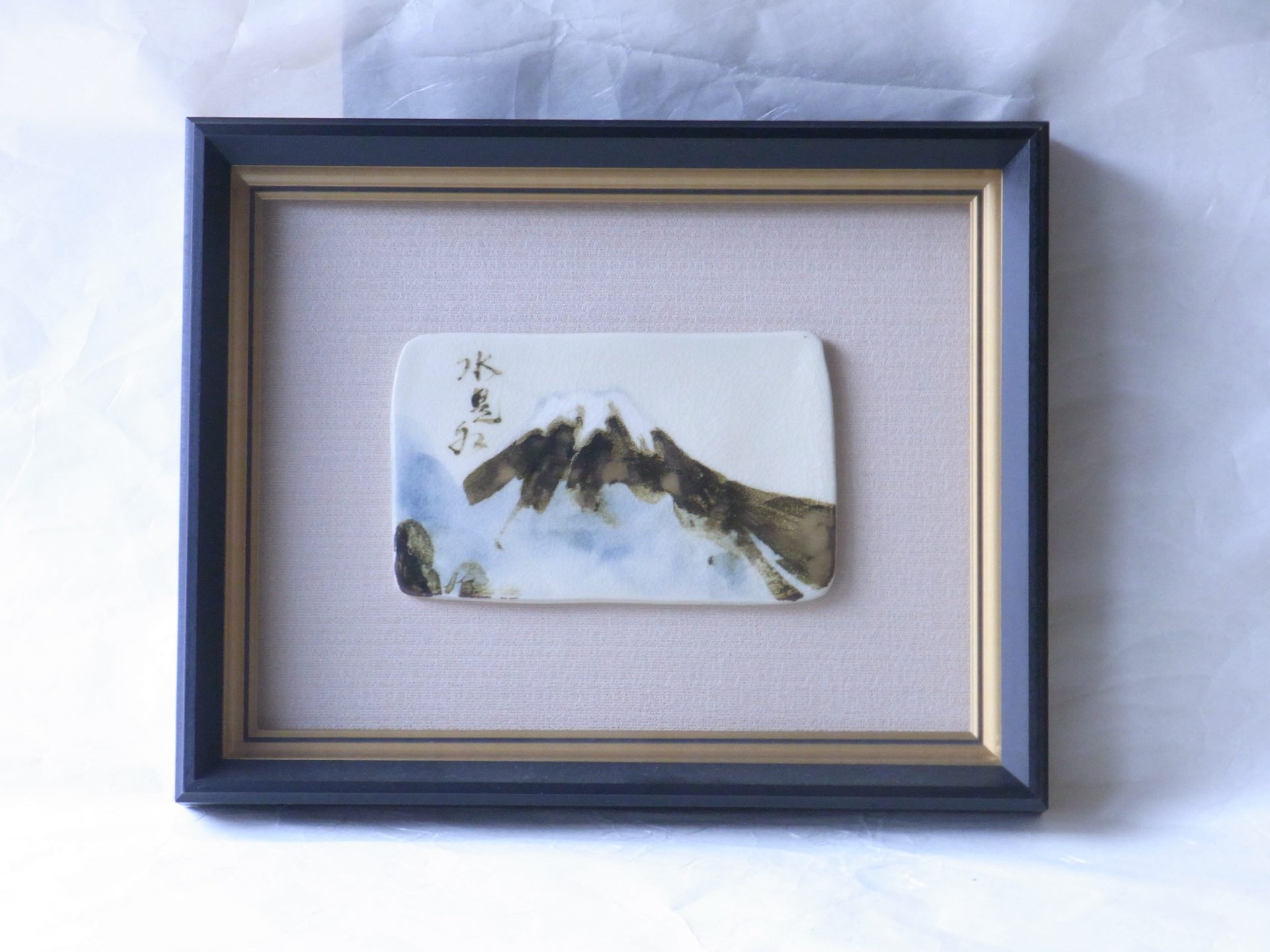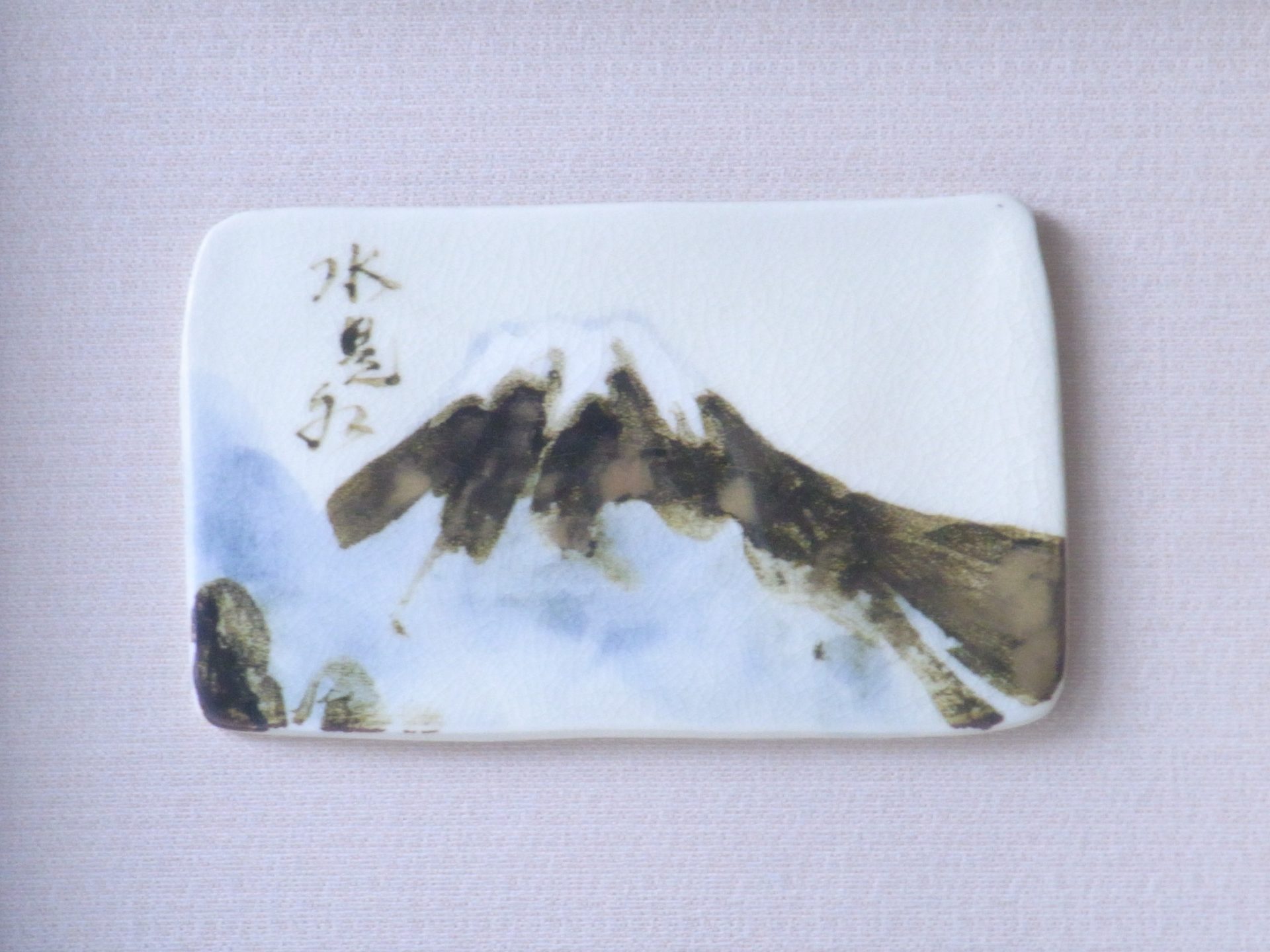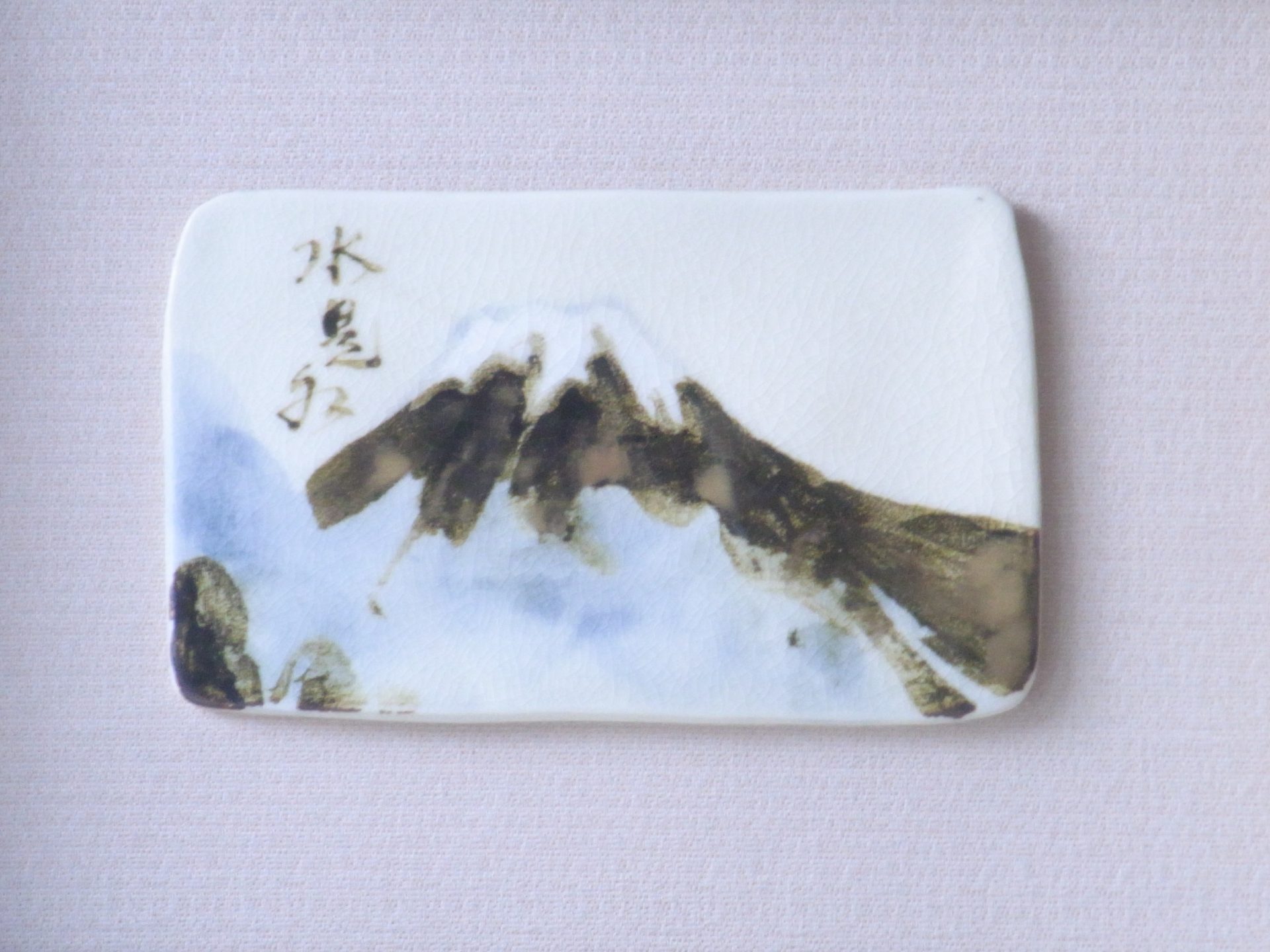清水焼から三代目 山川巌 作の鉄絵の富士山の陶額のご紹介です。
陶額とは、板状の陶器に絵付けをして焼いたものを
額に入れて飾るものです。
通常絵などは、紙やキャンパスに描いたものを額に入れて飾りますが
陶器に描いた絵は、紙やキャンパスに描いたものとは
趣きや雰囲気が異なり、独特な風合いが出て参ります。
また、紙やキャンパスなどに描いたものは水彩画や油絵でも、経年劣化があり
時代が経つと色があせたり変色して、元の色彩を維持することは
難しくなってきます。
従って、いずれは画の修復作業というものが必要となってきます。
しかし、陶板に絵付けをしたものは、何百度場合によっては千度以上で
焼き上げるので、経年劣化が起こりにくく、変色も極めて少ないので
元々の画の色をほぼ初期の状態のまま、維持することが出来ます。
劣化がほとんどない、陶額は非常に永く飾って頂けるという利点があります。
この陶額は富士山が描かれていますが、左上に「水是水」(みずこれみず)と
書かれています。
これは「山是山 水是水」(やまこれやま みずこれみず)という
禅語の一部を書いたもので「山是山」の部分は富士山で表現していると思われます。
画と書の両方で禅語を表わしています。
修行を積み、悟りをを開く境涯に至ると、山も水もすべてが
澄んだ目で見ることができるようになる。
すべての執着心を超克する境涯に至ることが大切であり
この域に達して、はじめて自然と人生の豊かさがほんとうに見え
味わいうるようになる、というような深い意味を表現しています。
ただ単に富士山が描かれただけの陶額ではなく、そこには「禅」の深い意味があり
物事の執着心を超越した澄んだ心が大切であることを教えてくれています。
29.5 × 23.5 × 3.2㎝
It is an introduction of the ceramic amount of Mt. Fuji of the iron painting of the third generation Yamakawa Akira from Shimizu ware.
The ceramic amount is the one baked by painting the pottery of the board
It is the one to put it in the forehead and to decorate it.
I usually put things on paper or on campus on my forehead and decorate them.
What kind of paintings did you draw on paper or on campus?
The taste and atmosphere are different, and a unique texture comes out.
In addition, even watercolors and oil paintings drawn on paper, campuses, etc.,
As time goes by, the colors will lose color and change color, and the original color will be maintained.
It’s going to be difficult.
Therefore, the restoration work of the picture becomes necessary sooner or more.
However, those painted on the ceramic plate, in some cases more than a thousand degrees
Because it is baked, it is less likely to cause aging, and there is very little deterioration.
It is possible to maintain the color of the original picture almost in its initial state.
There is little deterioration, and the pottery amount has the advantage that it can be decorated for a very long time.
This amount of pottery is depicted in Mt. Fuji, but in the upper left is “Mizu koremizu” (Mizumizu) and
It is written.
This is called “Yamakoyama Mizukomizu” (Yamakoyama Mizukomizu).
It is written a part of the Zen word, and the part of “Yama Koreyama” is thought to be expressed by Mt. Fuji.
Both pictures and books represent Zen language.
When it comes to the boundary where the training is piled up, and enlightenment is opened, the mountain and the water are all
You will be able to see it with clear eyes.
It is important to reach a situation that transcends all obsessive minds.
It is not until we reach this area that we can truly see the richness of nature and life.
It expresses a deep meaning that comes to be able to taste.
It’s not just the amount of pottery that Mt. Fuji was drawn on, but the deep meaning of Zen.
It teaches us that a clear mind that transcends the obsession of things is important.
介紹富士山的陶瓷價值,從清水燒到第三代山川弘治的鐵畫。
陶瓷的額頭是用板狀陶器繪畫和烘烤的。
這是放在額頭上和裝飾的東西。
通常,在校園內畫的紙張和東西放在額頭上,然後裝飾。
陶器上畫的畫是紙上畫的。
味道和氣氛不同,獨特的質地出來。
此外,在水彩畫和油畫中,在紙張和校園中描繪的東西可能會老化。
隨著時間的流逝,顏色會變色,保持原來的顏色。
它變得更難。
因此,最終需要修復圖片。
然而,在陶瓷板上畫的東西,在幾百度的情況下,超過一千度。
因為它烤,老化不太可能發生,變色也很少。
原始圖片的顏色可以保持,同時保持幾乎早期的狀態。
幾乎沒有惡化,有一個優勢,陶量可以裝飾很長一部分很長一點。
這種陶瓷價值描繪了富士山,但左上角有”水”和。
是書面的。
這是「山野山水」(山本山三澤)
據說,在寫禪宗部分時,富士山的一部分被表達出來。
在繪畫和書籍中,它代表禪宗。
當我完成訓練,並到達邊界,打開啟蒙,山和水都。
能夠用清澈的眼睛看。
重要的是,你超越所有癡迷的界限。
當我到達這個領域時,我才能真正看到自然和生活的豐富性。
它表達了一種深刻的含義,使味道變得令人難嘗。
不僅僅是畫富士山的陶瓷價值,還有”禪宗”的深刻含義。
它教會了我,超越事物的癡迷,清澈的心靈很重要。
介绍富士山的陶瓷价值,从清水烧到第三代山川弘治的铁画。
陶瓷的额头是用板状陶器绘画和烘烤的。
这是放在额头上和装饰的东西。
通常,在校园内画的纸张和东西放在额头上,然后装饰。
陶器上画的画是纸上画的。
味道和气氛不同,独特的质地出来。
此外,在水彩画和油画中,在纸张和校园中描绘的东西可能会老化。
随着时间的流逝,颜色会变色,保持原来的颜色。
它变得更难。
因此,最终需要修复图片。
然而,在陶瓷板上画的东西,在几百度的情况下,超过一千度
因为它烤,老化不太可能发生,变色也很少
原始图片的颜色可以保持,同时保持几乎早期的状态。
几乎没有恶化,有一个优势,陶量可以装饰很长一部分很长一点。
这种陶瓷价值描绘了富士山,但左上角有”水”和
是书面的。
这是”山野山水”(山本山三泽)
据说,在写禅宗部分时,富士山的一部分被表达出来。
在绘画和书籍中,它代表禅宗。
当我完成训练,并到达边界,打开启蒙,山和水都
能够用清澈的眼睛看。
重要的是,你超越所有痴迷的界限
当我到达这个领域时,我才能真正看到自然和生活的丰富性。
它表达了一种深刻的含义,使味道变得令人难尝。
不仅仅是画富士山的陶瓷价值,还有”禅宗”的深刻含义。
它教会了我,超越事物的痴迷,清澈的心灵很重要。



